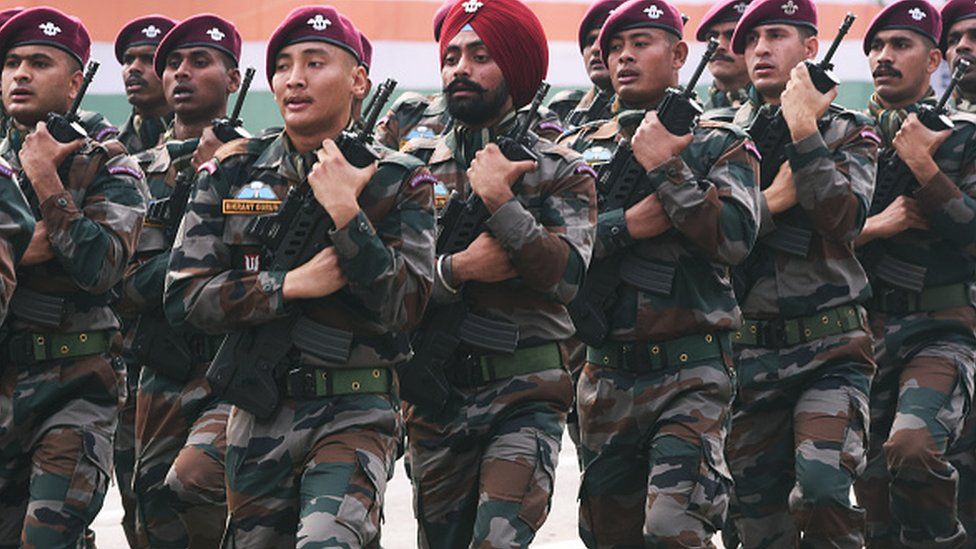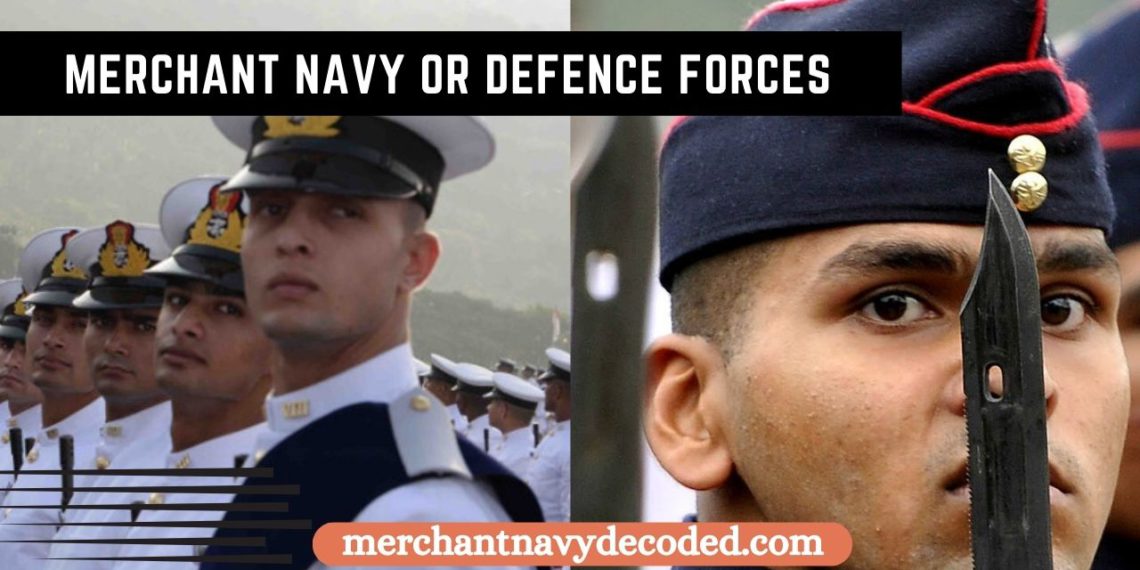Merchant Navy or Defence Forces | Which Career Path is suitable for you?
Table of contents
- Overview
- What is the Merchant Navy ?
- What is a Defence Force?
- Pathways to Joining the Merchant Navy and Armed Forces
- Examination and Syllabus
- Selection Statistics and Success Rates
- Eligibility
- Similarities Between the Merchant Navy and Defence Services
- Difference Between Merchant Navy and Defence forces
- Privileges
- Sacrifice
- “Sher Shah of Kargil” Captain Vikram Batra
- Rank, Promotion, and Salary
- Conclusion
Overview
Choosing between a career in the Merchant Navy or the Defense Forces is a pivotal decision that demands careful consideration. The Merchant Navy offers adventure on the high seas, with opportunities for travel and substantial financial rewards. On the other hand, the Defense Forces provide a sense of duty, discipline, the chance to serve our country, and the security of a stable job.
Let’s explore both career paths to help you make an informed and exciting choice.
What is the Merchant Navy?

The Merchant Navy is a civilian ship fleet that transports goods and people worldwide. It’s not a military navy. People who work on these ships, like officers and crew, help move goods internationally and ensure safe voyages. This helps support global trade and economic growth.
What is a Defence Force?
A defence force, also known as a military or armed force, is a government organization responsible for protecting a country’s security and sovereignty. It consists of various branches, such as the army, navy, air force, and sometimes other specialized units. These forces are trained and equipped to defend against external threats and maintain national security.
Pathways to Joining the Merchant Navy and Armed Forces
Merchant Navy
To pursue a career in the Merchant Navy, you can choose from various courses such as:
- B.Tech in Marine Engineering
- Diploma in Nautical Science
- BSc in Nautical Science
- Graduate Marine Engineering
However, to embark on this exciting journey, you’ll need to pass the IMU CET (Indian Maritime University Common Entrance Test) examination.
Defence Forces
Joining the defence forces in India is an honorable and challenging endeavor. There are several ways to become a part of the Indian Armed Forces:
- National Defense Academy (NDA)
- Combined Defense Services (CDS) Exam
- Territorial Army
- Short Service Commission (SSC)
- Technical Entries (UES, TGC)
- NCC Special Entry
- Medical and Dental Corps (AFMS, AFDS)

Examination and Syllabus
The Indian Maritime University Common Entrance Test (IMU CET)
- The Indian Maritime University Common Entrance Test (IMU CET) is a competitive examination conducted by the Indian Maritime University (IMU). It serves as the entrance exam for various undergraduate and postgraduate programs related to the maritime industry in India.
- The Indian Maritime University Common Entrance Test (IMU CET) is conducted twice a year.
The IMU CET (Indian Maritime University Common Entrance Test) syllabus covers various subjects:
- Physics
- Chemistry
- Mathematics
- English
- General Knowledge
- General Aptitude
National Defence Academy Examination (NDA)
- The NDA exam refers to the National Defence Academy Examination, which is a competitive examination conducted in India for the recruitment of candidates into the Indian Armed Forces. The NDA is a premier military academy that trains young individuals to become officers in the Indian Army, Navy, and Air Force.
- The National Defence Academy Examination is conducted twice a year.
- The National Defence Academy Examination syllabus covers various subjects:
- 1. Mathematics: This part focuses on basic math concepts. You’ll need to understand numbers, shapes, triangles, and some advanced math like calculus and statistics.
- 2. General Ability Test (GAT): This part has two sections:
- A. English: It checks your English language skills, including words, grammar, and reading.
- B. General Knowledge: This section covers various topics like science, history, geography, current events, politics, economics, Indian laws, and general problem-solving abilities.
Selection Statistics and Success Rates
| Exam Name | IMU CET (2017) | NDA |
| Appeared Candidates | 22.500 | 6,00,000 |
| selected | 995 | 400 |
| Selection Rate | 4.42% | 0.066% |
- The selection rates for entry into the defence forces in India can be relatively low compared to the Merchant Navy exams. This is primarily because the defence forces have stringent eligibility criteria, a challenging selection process, and a limited number of vacancies available each year.
- The selection process for defence forces typically involves a written examination, followed by an interview, group discussions, psychological tests, physical fitness assessments, and medical examinations. These rigorous evaluations are designed to ensure that only the most qualified and capable candidates are admitted.
Eligibility
| Criteria | IMU CET | NDA (for Army) | NDA (for Air Force and Naval Wings) |
| Educational Background | Science Background | All Backgrounds (Art & Commerce included) | Science Background (Physics, Chemistry, and Mathematics) |
| Percentage in Class 12th | PCM – 60%, English – 50% | Not Applicable | Not Applicable |
| Age Limit | 17-25 years | 15.5-18.5 age 16 or 19 years old during the commencement of the course | 15.5-18.5 age 16 or 19 years old during the commencement of the course |
| Physical Standards | Less Stringent | High Standards | High Standards |
Similarities Between the Merchant Navy and Defence Services
- Staying away from family
Both careers, Merchant Navy and Defence Forces, share the common aspect of requiring personnel to stay away from their families for extended durations. This shared sacrifice fosters resilience and a deep sense of camaraderie among individuals in these professions
- Hardship and tough life
Merchant Navy and Defense Forces entail arduous challenges and demanding lifestyles. The shared similarity lies in the rigorous discipline, extended periods away from home, and the need to perform under pressure in ever-changing environments. These careers demand resilience and a strong sense of duty from those who choose them.
- Food and lodging are free during the service
Merchant Navy and the Defense Forces, a notable similarity lies in the provision of free food and lodging during service. This essential perk not only ensures the well-being of individuals serving in these esteemed professions but also contributes to financial savings and a sense of security, fostering a strong camaraderie among personnel.
- Good communication skills
Strong communication skills are a shared necessity in both the Merchant Navy and the Defense Forces. Whether on a ship at sea or engaged in military operations, effective communication is crucial. It facilitates seamless coordination among crew or team members, ensures safety, and enhances task execution. Clear and concise communication is vital for conveying critical information, maintaining teamwork, and minimizing risks
- Examination for promotion
Merchant Navy and the Defense Forces, the need to clear examinations for promotions is a common thread that underscores the importance of knowledge and skill development. These examinations serve as a yardstick to assess competence and readiness for higher responsibilities. This shared emphasis on continuous learning and growth ensures that individuals in both fields are well-equipped to excel in their respective roles and contribute effectively to their organizations’ missions.
Difference Between Merchant Navy and Defence forces
| Aspect | Merchant Navy | Defense Forces |
| Primary Mission | Commercial Shipping and Trade | National Defense and Security |
| Career Focus | Maritime Industry and Trade | Military and Defense |
| Uniform | Often casual attire, uniforms during official duties | Uniforms as standard attire |
| Deployment | International voyages and trade routes | National and international deployments |
| Promotions and Advancement | Primarily based on experience and certification(Faster Promotion) | Hierarchical structure with promotions based on rank and merit(Slow Promotion) |
| Easier to get a promotion | Tough to get to the topmost position | |
| Company and Job | You can change your company You can ask questions | No question asked Need to follow orders Country comes first |

Privileges
| Privilege | Armed Forces | Merchant Navy |
| Comprehensive Medical Insurance | Typically provided to all personnel and their families | Coverage varies by employer and may not always include family members |
| Post-Retirement Benefits | Pension and healthcare benefits for retirees | No Provident Fund |
| Educational Assistance for Dependents | Access to subsidized education for children | No Assistance |
| Housing Facilities | Provided with accommodation or housing allowances | Accommodation arrangements vary by employer |
| Commute and Travel | Government-provided transportation and travel benefits | Travel arrangements are provided by the company during sign-on and sign-off. |
Sacrifice
The Indian Armed Forces show incredible sacrifice by risking their lives to keep our country safe. They might get hurt, spend a long time away from family, or face tough conditions, but they do it all to protect us. They’re very brave and devoted to our country, and we should always appreciate their sacrifices.
“Sher Shah of Kargil” Captain Vikram Batra
Captain Vikram Batra, known as the “Sher Shah of Kargil,” was a fearless Indian Army officer who displayed exceptional courage during the Kargil War in 1999, ultimately sacrificing his life for his country while capturing a crucial peak. His indomitable spirit and dedication continue to inspire generations.
Rank, Promotion, and Salary
Merchant Navy
| Rank | Salary(Dry Vessel) | Salary (Tanker Vessel) |
| Captain/ Chief Engineer | 8,000$-10,000 $ | 9,000$-14,000 $ |
| Chief officer/ 2nd Engineer | 6,500$-8,500 $ | 7,500$-9,500 $ |
| 2nd officer/ 3rd Engineer | 4,000$-4,800 $ | 4,000$-5,000 $ |
| Deck Cadet/ Engine Cadet | 350$-750 $ | 350$-750 $ |
Defence Forces
| Rank | Service | Salary (Rupees) |
| Field Marshal | Never Retires | |
| General/ COAS | 32+ Years | ₹2,50,000 |
| Lt General | 32 Years | ₹2,24,000 |
| Major General | 25 Years | ₹1,44,200-₹2,18,200 |
| Brigadier | 25 Years | ₹1,39,600-₹2,17,600 |
| Colonel | 13 Years | ₹1,13,600-₹2,17,600 |
| Lt Colonel | 13 Years | ₹1,21,200-₹2,12,400 |
| Major | 6 Years | ₹69,400-₹2,07,200 |
| Captain | 2 Years | ₹61,300-₹1,93,900 |
| Lieutenant | After Commissioning | ₹56,100-₹1,77,500 |
“You should have to fight and fight to win. There is no roof for the losers. If you lose, don’t come back. You will have disgraced the country and the country won’t accept you.”
-Field Marshal Sam Manekshaw
Conclusion
In conclusion, choosing between a career in the Merchant Navy and the Defence Forces ultimately depends on your personal goals, values, and aspirations. The Merchant Navy offers a unique blend of adventure and commerce, while the Defence Forces provide a sense of duty and national service. Consider your interests, lifestyle preferences, and long-term ambitions carefully to make the right decision for a fulfilling and rewarding career path. Your choice will shape not only your future but also your sense of purpose and fulfillment in life.
If you have any doubts or questions, please leave a comment below.
Is Merchant Navy A Government Job|Decoding Salaries, Global Travel Opportunities, and More (2023), Refer to this blog.
Disclaimer :- The opinions expressed in this article belong solely to the author and may not necessarily reflect those of Merchant Navy Decoded. We cannot guarantee the accuracy of the information provided and disclaim any responsibility for it. Data and visuals used are sourced from publicly available information and may not be authenticated by any regulatory body. Reviews and comments appearing on our blogs represent the opinions of individuals and do not necessarily reflect the views of Merchant Navy Decoded. We are not responsible for any loss or damage resulting from reliance on these reviews or comments.
Reproduction, copying, sharing, or use of the article or images in any form is strictly prohibited without prior permission from both the author and Merchant Navy Decoded.



